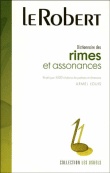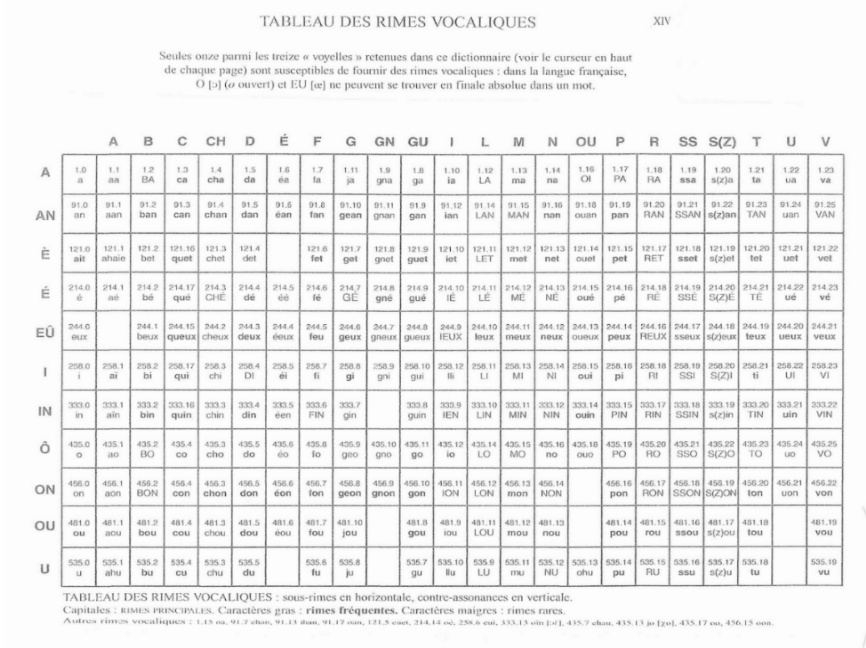Reviewed by Françoise Herrmann

Publisher: Le Robert – Collection Les Usuels - France
Publication date: 2006
ISBN: 2849023159
Price €22.50
Available from: www.amazon.com
Dictionnaire des rimes et assonances - Armel Louis
Reviewed by Françoise Herrmann

Publisher: Le Robert – Collection Les Usuels - France
Publication date: 2006
ISBN: 2849023159
Price €22.50
Available from: www.amazon.com
Figure 1: Look-up table - Vocalic rhymes
The FAQs section supplies answers concerning no fewer than 60 types of rhymes. This presentation of rhymes is infused with a strong diachronic approach that almost mirrors an all-inclusive history of music from classical to hip-hop and rap, via jazz and rock and roll. Along the way you will find out, for example, that rhyme is a specialized form of assonance. You will also discover, among the many types of rhymes presented, the characteristics of a rime interjective, narcissique, acrostiche, babélienne, intérieure, batelée, voyageuse, brisée, cachée, cryptée, suivie, redoublée, parallèle, en miroir, combinée, disjointe... (interjective, narcissistic, acrostic, babelian, interior, tumbling, traveling, broken, hidden, cryptic, consecutive, double, in parallel, mirroring, combined and disjointed rhymes), and many more! Each of the different kinds of rhymes is illustrated with a citation or referenced to the citations in text, providing both clarification and ease of reading, as well as pleasure in accessing snippets of poetry, song and verse from well-known authors.
Le Robert’s Dictionnaire des Rimes et Assonances contains two tables: a table of vocalic rhymes and a table of consonant rhymes that together provide easy look-up of the 588 types of rhymes contained in the dictionary (refer to Table 1 for a reproduction of the vocalic table). For example, say you are looking for rhymes that end in feu, you will find at the intersection of eû and F a reference to the feu rhyme type (No. 244.5). And in section 244.5 of the dictionary, a list of rhymes in feu, appearing according to frequency of occurrence, illustrated with citations and cross-referenced with assonances and counter-assonances. These look-up tables are most useful, as they enable you to bypass flipping pages, which greatly speeds-up direct access to the searched rhymes. And for those with a background in prosody, or a specialization in literary translation, the look-up tables will also provide you with an immediate presentation of the rhyme typology devised and retained by Armel Louis.
The listing, divided into 588 categories of rhymes, comes to life and is in general immensely enhanced with the presence of citations for the purpose of illustration. The marvelous selection of citations culled from the works of well-known authors, poets and song-writers, such as Guillaumme Apollinaire, Arthur Rimbaud and Georges Brassens (among 447 other famous voices), appears as snippets that are long enough to convey wisdom beyond the illustrated rhymes. They carry both the intended didactics and an additional dimension of art sample that could even send you to the bibliographic source for more. The listings found in the 588 types of rhymes also supply cross-references to assonances and counter-assonances. In the above example, section 244.5 for rhymes in Feû lists a "neighboring sub-rhyme" reference to Veux [244.21], appearing as assonance, as well as two counter-assonances Fin-fun [333.6], and Fou-e [481.7], each in turn illustrated with citations to further insight into how these sounds systematically relate.
Le Robert’s Dictionnaire des Rimes et Assonances is a magnum opus in the domain of French versification. For French translators, both literary and technical, this is a reference tool of institutional stature. For technical translators, I shall warrant the ease with which you will access the rhymes you seek. Whether you are translating a jingle, a corporate logo, an advertisement, the ear- and eye-catching headers of a brochure or packaging, when you need to find words that rhyme or when you want words with a particular sound or "counter-sound", you will find this reference both invaluable and a pleasure to use. Additionally, you will be able to rely on the small and congenial introductory presentation of prosody to inform your choice of rhymes and to infuse your response to the sounds of your source text with both knowledge of the classics and wit. Le Robert’s Dictionnaire des Rimes et des Assonances is a substantial reference tool that definitely belongs on your desk. Get it and enjoy!